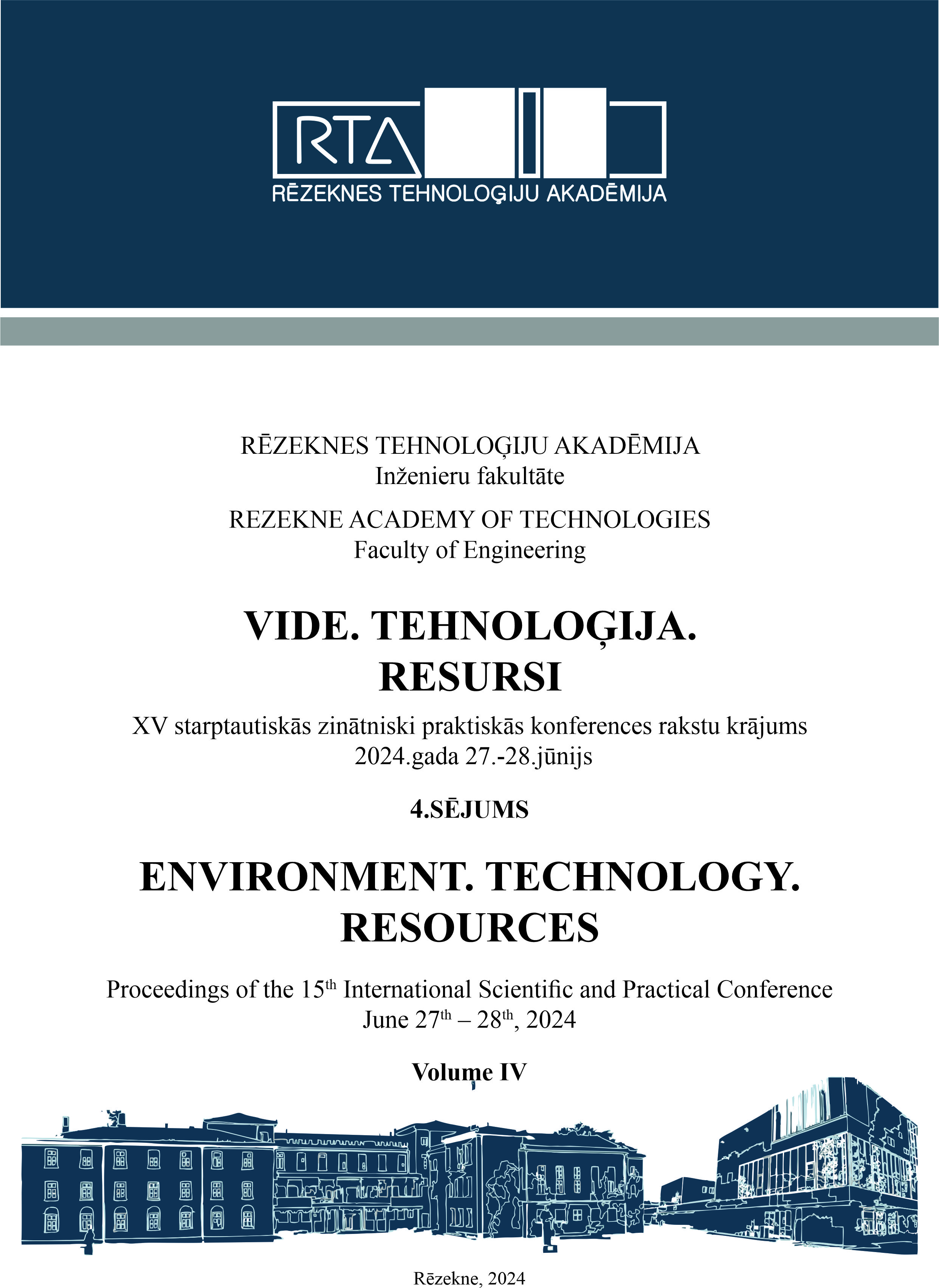NIGHT VISION MONOCULAR - BASIC ELEMENTS AND DEVELOPMENT TRENDS
DOI:
https://doi.org/10.17770/etr2024vol4.8211Keywords:
image intensifier, infrared, monocular, night visionAbstract
This article examines the fundamental elements and evolving trends in night vision monocular devices. The topicality of this topic lies in the ongoing advancements in sensor technologies, optics, and digital processing, which continually enhance the performance and accessibility of night vision devices. The purpose of this study is to provide a comprehensive overview of the basic components and recent developments in night vision monoculars. The study adopts a comparative analysis approach, examining the key features and functionalities of different generations of night vision technology and investigates emerging trends such as miniaturization, improved image resolution, and integration with digital interfaces. The methodology involves a thorough review of literature encompassing scientific articles, patents, and technical reports related to night vision technologies. Key aspects studied include image intensifier tubes, infrared sensors, objective lenses, and display systems. Additionally, recent research articles, technical reports, and product specifications are analyzed to identify emerging trends in monocular design and performance, in digital image processing algorithms and the integration of augmented reality functionalities. The findings underscore the importance of ongoing research and development in improving the performance and accessibility of night vision monoculars. Key conclusions include the growing role of digital imaging in night vision devices, the potential for further miniaturization of components, and the importance of optimizing cost-efficiency without compromising performance. In summary, this article provides insights into the foundational components and evolving trends of night vision monoculars, emphasizing the technological advancements driving the development of next-generation night vision devices. The findings contribute to a deeper understanding of the current state and future prospects of night vision technology.References
D. Borissova, Night vision devices. Modeling and Optimal Design. Prof. Marin Drinov Publishing House of Bulgarian Academy of Sciences, ISBN 978-954-322- 829-4, 2015.
K. Chrzanowski, “Review of night vision technology”, Opto-electronics review, vol. 21(2), pp. 153-181, DOI: 10.2478/s11772-013-0089-3, 2013.
M. J. Haque and M. Muntjir, “Night Vision Technology: An Overview”, International Journal of Computer Applications (0975 – 8887), Vol. 167 – No.13, pp. 37-41, DOI:10.5120/ijca2017914562, June 2017.
Basic knowledge of night vision, 2020. [Online] Available: Basic knowledge / FAQ about night vision - ALPHA PHOTONICS (alpha-photonics.com), [Accessed: Feb. 27, 2024].
H. P. Montoro, ITT Night Vision, “Image Intensification: The Technology of Night Vision”. [Online] Available: Image Intensification: The Technology of Night Vision | Imaging | Photonics Spectra, [Accessed: Feb. 27, 2024].
J. E. Weyne, Photonis Night Vision, “Differences between Gen3 and 4G image intensification technology”. [Online] Available: Difference_Gen3_4G_english_version.pdf (exosens.com), [Accessed: Feb. 27, 2024].
T. Jacks, “The basic guide to night vision”, Thomas Jacks Ltd 2009, [Online] Available: A BASIC GUIDE TO NIGHT VISION - Thomas Jacks - [PDF Document] (vdocuments.mx), [Accessed: Feb. 26, 2024].
UL PVS-14 Night Vision Monocular. Online] Available: NVD-UL-14.pdf (nvdevices.com), [Accessed: Feb. 27, 2024].
NVS 14-3AG Auto-Gated Night Vision Monocular. [Online] Available: NVS143AG.pdf (newcon-optik.com), [Accessed: Feb. 27, 2024].
The lightest and most compact night vision monocular, Thales. [Online] Available: 130326 MONIE (instigo.ee), [Accessed: Feb. 27, 2024].
[MNVD-51 Gen 3 Bravo Night Vision Monocular. Online] Available: MNVD-51 Gen 3 Bravo Night Vision Monocular | Armasight, [Accessed: Feb. 26, 2024].
Enhanced night vision goggle (ENVG) AN/PSQ-20B. [Online] Available: Enhanced Night Vision Goggle (ENVG) AN/PSQ-20B | L3Harris® Fast. Forward., [Accessed: Feb. 26, 2024].
C. Nicholas, Friday Night Lights: Enhanced Night Vision Goggle (ENVG) PSQ-20 B Thermal Fusion Monocular. Oct. 30, 2020. [Online] Available: Friday Night Lights: Enhanced Night Vision Goggle (ENVG) PSQ-20 B Thermal Fusion Monocular -The Firearm Blog, [Accessed: Feb. 26, 2024].
Enhanced Night Vision Goggle (ENVG), AN/PSQ-20. [Online] Available: ENVG AN/PSQ-20 - [PDF Document] (vdocuments.net), [Accessed: Feb. 26, 2024].
Enhanced Night Vision Goggle (ENVG), AN/PSQ-20. [Online] Available: PEO Soldier | Portfolio - PM IVAS - Enhanced Night Vision Goggle (ENVG), AN/PSQ-20 (army.mil), [Accessed: Feb. 26, 2024].
ITT Night Vision, Enhanced Night Vision Goggle (ENVG), AN/PSQ-20, F6023, 2009, ITT Rev. 2-09. [Online] Available: Wayback Machine (archive.org), [Accessed: Feb. 27, 2024].
Enhanced Night Vision Goggle – Binocular (ENVG-B). [Online] Available: PEO Soldier | Portfolio - PM IVAS - Enhanced Night Vision Goggle – Binocular (ENVG-B) (army.mil), [Accessed: Feb. 26, 2024].
Ground Systems, Binocular, Enhanced Night Vision Goggle (F6025). [Online] Available: Night Vision - Aviation & Ground Systems (elbitamerica.com), [Accessed: Feb. 27, 2024].
U.S. Army acquisition program portfolio 2023-2024. ENVG-B: “Production & Deployment” [Online] Available: U.S. Army Acquisition Program Portfolio 2023-2024, [Accessed: Feb. 27, 2024].
V. Dinesh Reddy, Sai Vishnu Vamsi Senagasetty, Krishna Teja Vanka, Mohana Vamsi Dhara, Rupini Durga Puvvada, Muzakkir Hussain, “Nighttime Object Detection: A Night-Patrolling Mechanism Using Deep Learning”, Handbook of Research on AI Methods and Applications in Computer Engineering, IGI Global, pp. 514-541, ISBN 978-166-846-937-8, 2023.
S. Singh, H. Singh, G. Bueno, O. Deniz, S. Singh, H. Monga, P.N. Hrisheekesha, A. Pedraza, “A review of image fusion: Methods, applications and performance metrics”, Digital Signal Processing, vol. 137, 104020, ISSN 1051-2004, 2023.
S. Singh, H. Singh, N. Mittal, H. Singh, A. G. Hussien, F. Sroubek, “A feature level image fusion for Night-Vision context enhancement using Arithmetic optimization algorithm based image segmentation”, Expert Systems with Applications, Vol. 209, 118272, ISSN 0957-4174, 2022.
A. Punnappurath, A. Abuolaim, A. Abdelhamed, A. Levinshtein and M. S. Brown, “Day-to-Night Image Synthesis for Training Nighttime Neural ISPs”, 2022 IEEE/CVF Conference on Computer Vision and Pattern Recognition (CVPR), New Orleans, LA, USA, pp. 10759-10768, DOI: 10.1109/CVPR52688. 2022.01050, 2022.
Downloads
Published
Issue
Section
License
Copyright (c) 2024 Iliya Stoychev, Iliyan Hutov

This work is licensed under a Creative Commons Attribution 4.0 International License.



